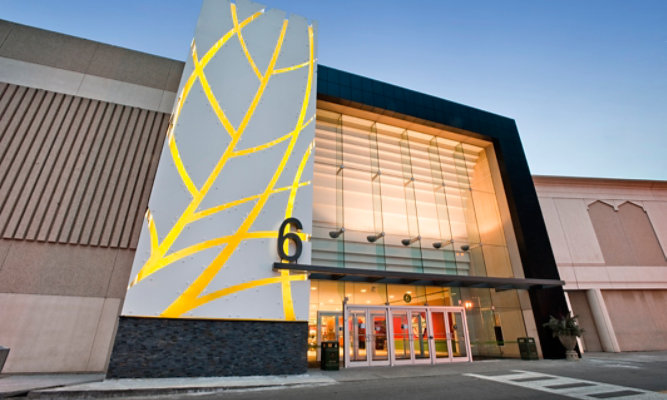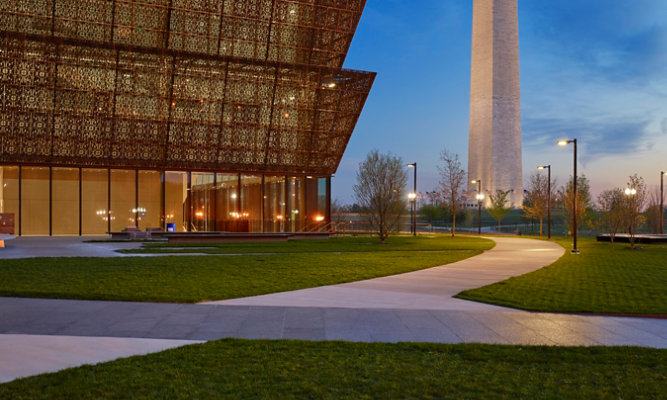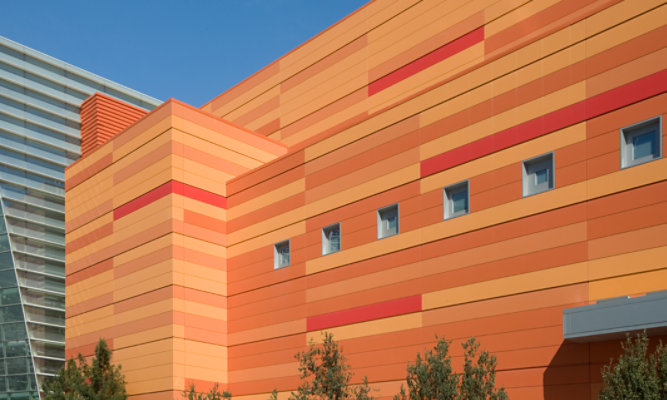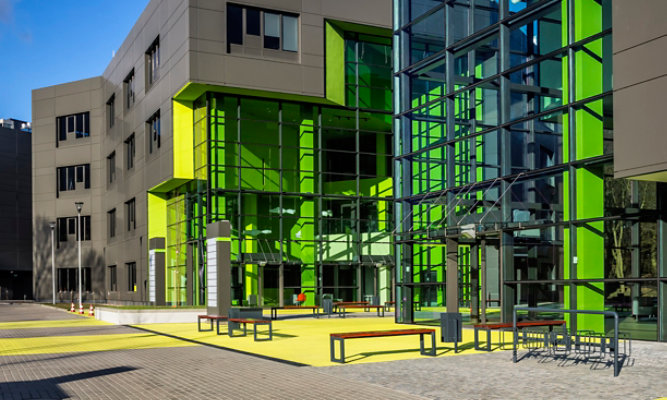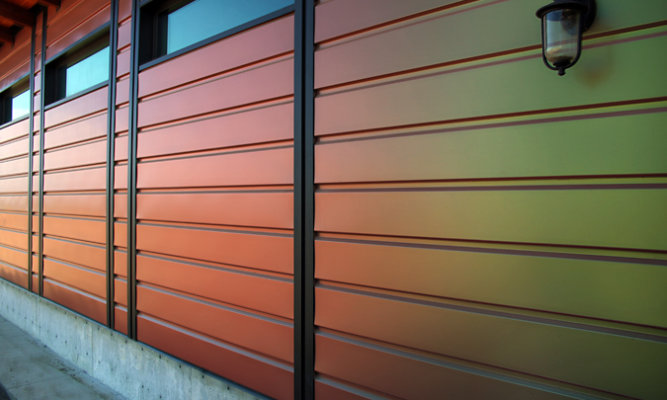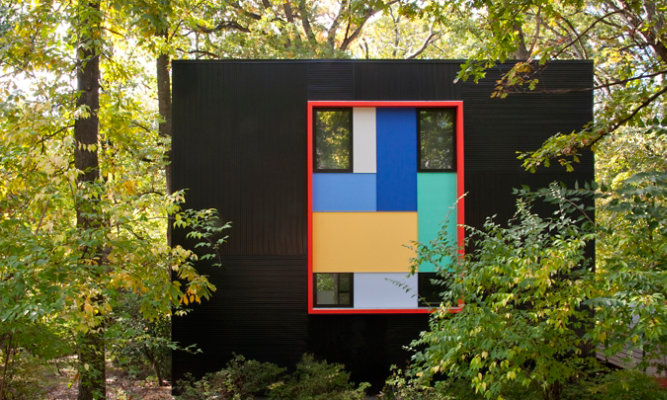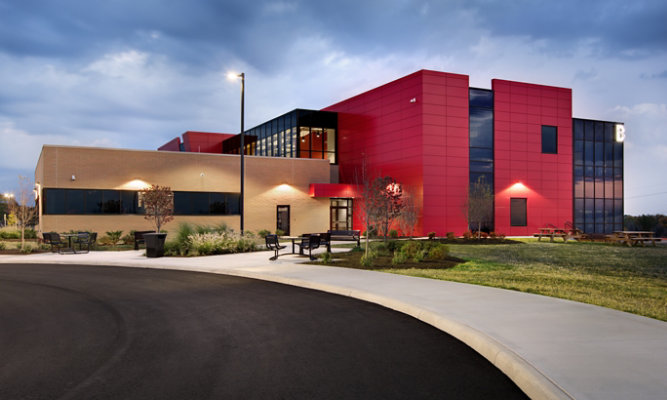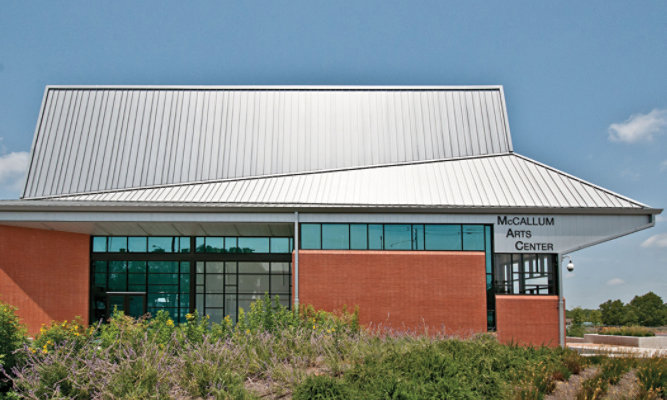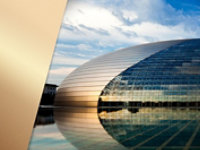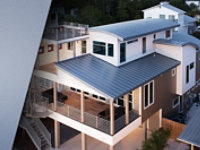The Color of Metal
Chemistry, light and method come together to create the look of metal components.
Color is a major element in a designer’s thought process. It plays an important role in aesthetic decisions made for the design of structures and buildings of all kinds. The artistic side of an architect’s mind also understands that color isn’t as simple as red, blue, yellow or green. There are countless variations on the color spectrum, and achieving just the right shade of a particular color can be very important.
However, hitting the mark with color isn’t as easy as going to the crayon box. Understanding the technology and chemistry of color can help designers ensure they specify building components that meet the aesthetic and performance needs of their projects.
“Color is defined by two things: the chemistry of a pigment and the type of light that shines on it,” explains Mike Churchill, technical manager for extrusion coatings with Valspar in Garland, Texas. “Using only one light source, a given color could be matched with multiple pigment combinations, but change the light source and these matches will look visually different from one another. That’s called a ‘metameric match.’ For exterior applications, we default toward a daylight or D65 light source for the match. It simulates the spectrum of visible light at noon, which is a roughly even distribution at all visible wavelengths.”
Sometimes color matches submitted to a design team for approval may look off the mark under office lights. It’s important to note the kind of light source used to view the coated panel. “Colors are matched using a daylight illuminant or source,” says Jay Register, group project leader out of Valspar's Coil Group Laboratory in Garland. “If our color match is then viewed by the customer in fluorescent lighting versus the customer’s submitted chip, the two colors may not appear to be as close a match as the customer would like.”
On a building component, the pigment itself, the substrate, and any clear coating applied over the color all make a difference in how a color appears to the eye of a passerby. The final look also is affected by how the paint is applied to the material. With architectural metal components, color is generally either spray applied or coil coated. Each method has its own unique characteristics. “In general, the coating application depends on the component of the building,” Register says. “Extruded and curtain wall components will be spray applied. For roofing and side wall panels, the color coatings will be coil coated.”
Because the two approaches are fundamentally different, each has its own considerations. Spray is generally applied to components that are already formed, while coil coating is applied to raw metal coil that is later shaped into panels and pieces. “In spray application, the coating comes out the tip of a gun, and most applications are electrostatic,” Churchill says. “An electrical charge is given to the atomized paint, and the part is grounded, so an electrical field is established between the gun and the part. The paint travels along the electrical field to that grounded part. Electrifying the paint allows you to paint both sides of the part by spraying only the front side, because the paint will follow the electrical field and wrap around and cover the back side of the part.”
“Coil coating is a continuous and highly automated process for coating metal before fabrication,” Register says. “In one continuous process, a coil of steel or aluminum that can be as wide as 72 inches and moving up to speeds as fast as 700 feet per minute is unwound and both the top and bottom sides are cleaned, chemically treated, primed, oven cured, top coated, oven cured again, rewound and packaged for shipment. Typically the applicator roll turns in the opposite direction of the strip, and thus the process is called reverse roll coating. This process can place a significant shear on the coating, but it allows for high levels of control of both film thickness and color.”
The difference in the two application methods and their planes of application necessitates a different rheology for the coatings when applied in a coil application versus a spray application. Rheology is the science of flow and deformation. Flow phenomena can be very complex. The simple action of stirring paint in a can involves flow patterns that can be a challenge for exact mathematical analysis.
In coil coating, the application plane is horizontal, and a high shearing stress is applied to the coating for a brief period at the point where the application roll meets the moving metal strip. Having only a horizontal application plane means that, after application, the coating will not run or sag. As a result of coil rheology and application, coil films have a slightly more uniform appearance for color and gloss and a more consistent dry film thickness, with a slightly smoother flow pattern.
With spray, a high shearing stress occurs briefly at the gun tip where the paint is atomized and charged. Application planes for spray can be in any direction or angle and often are vertical. As a consequence of the multi-angle applications, the viscosity of spray coatings must build back higher and faster following release of shear stress in order to prevent the coating from sliding or running down the various angles on the part. Spray rheology and application mean that the part may have a slightly less uniform appearance for color and gloss and a bit more variation in dry film thickness across the part. The flow pattern also will be slightly more irregular than a coil coating.
Featured Articles
“Color is defined by two things: the chemistry of a pigment and the type of light that shines on it.”
The number of coats applied to a component can vary, depending on the project specifications. “Many architects work with AAMA (American Architectural Manufacturers Association) specifications, which don’t call for a certain number of coats,” Churchill says. “They give minimum total dry film thickness requirements and other end-use specifications, such as gloss retention, chalk rating and color fade following a period of exterior exposure. A third coat will add an extra barrier layer and will protect better against UV degradation and hydrolysis.”
Pigments used on building components need to do more than just show a color, however. They also have to be durable to the elements, which adds more chemistry to the equation. “Sometimes architects will request a color from a book of swatches, and that can be problematic when you are looking for long lasting warranties,” Churchill says. “To coat a piece of paper, you can essentially use any pigment you want, because there are no durability requirements for the pigment. It only needs to be a particular color that can be realized on a piece of paper. When it gets back to us, we have only a very limited palette of pigments that have the requisite durability to meet those kinds of warranties. The systems we work with [in spray applied and coil coating] are basically the same polymeric systems — varying only in the rheology — and at least the coatings themselves have pretty much the same durability. The slight difference is that with coil you have a greater variation in substrates, where with [spray-coated extruded components] you coat only aluminum.”
It can be easier for architects to find a color that complements the overall aesthetic of the building while delivering the necessary durability and performance if they bring the material manufacturer to the table early in the design process.
“Color choice can be a critical component,” Register says. “At times the design requirements are in conflict with each other in terms of color and performance requirements. It helps to have a knowledge of what the coating system can and cannot do when establishing or meeting specifications for a given project.”
By Henry Burke
Metal Mag, Spring
Editor's Note: This article was originally published on April 26, 2014. Valspar was acquired by The Sherwin-Williams Company on June 1, 2017.
